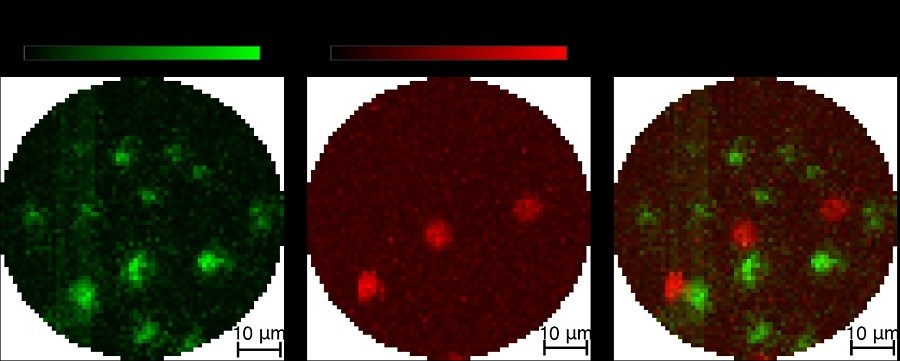Sep 22 2020
A new endoscope was recently demonstrated by a team of scientists which exclusively integrates fluorescent and photoacoustic imaging in a device that has roughly the thickness of a human hair.
 The researchers demonstrated their new device by using it to image fluorescent beads (green) and red blood cells (red). The field-of-view is the size of a hair. Image Credit: Emmanuel Bossy, Laboratory of Interdisciplinary Physics, University of Grenoble Alps, CNRS.
The researchers demonstrated their new device by using it to image fluorescent beads (green) and red blood cells (red). The field-of-view is the size of a hair. Image Credit: Emmanuel Bossy, Laboratory of Interdisciplinary Physics, University of Grenoble Alps, CNRS.
In the future, this device could offer new insights into the brain by allowing blood dynamics to be quantified simultaneously as neuronal activity.“Combining these imaging modalities could improve our understanding of the brain’s structure and behavior in specific conditions such as after treatment with a targeted drug. The endoscope’s small size helps minimize damage to tissue when inserting it into the brains of small animals for imaging.
Emmanuel Bossy, Study Team Leader, Laboratory of Interdisciplinary Physics, University of Grenoble Alps, CNRS
In Biomedical Optics Express, the journal of Optical Society (OSA), Bossy’s research group, in association with Paul C. Beard’s team from the University College London, explained their novel multi-modality endoscope and demonstrated that it can obtain fluorescent and photoacoustic images of fluorescent beads and red blood cells.
Two Images are Better Than One
Capturing photoacoustic and fluorescence images with the same device offers automatically co-registered images with complementary data. Fluorescent signals, which are produced when a fluorescent marker captures light and re-produces it with a diverse wavelength, are highly beneficial for marking particular areas of tissue.
Conversely, photoacoustic images (which trap an acoustic wave produced following the absorption of light) do not need labels and therefore, for instance, can be applied to image blood dynamics.
The latest endoscope uses a method known as 'optical wavefront shaping' to produce a focused spot of light at the imaging tip of a tiny multi-mode optical fiber.
Light propagating into a multi-mode fiber is scrambled, making it impossible to see through the fiber. However, this type of fiber is advantageous for endoscopy because it is extremely small compared to the bundles of imaging fibers used for many medical endoscopic devices.
Emmanuel Bossy, Study Team Leader, Laboratory of Interdisciplinary Physics, University of Grenoble Alps, CNRS
To observe through the multi-mode optical fiber, the team utilized the spatial light modulator to transmit certain light patterns via the fiber and produce a focus spot at the imaging end. Upon striking the sample, the focus spot forms a signal that can be used to create an image point by point by raster scanning the spot across the sample.
While other scientists have made use of multi-mode fibers for fluorescence endoscopy, the latest study signifies the first time that photoacoustic imaging has been integrated into this type of endoscope design.
Adding Sound Sensitivity
The team subsequently added photoacoustic imaging by combining an extra, very thin optical fiber with a unique sound-sensitive sensor tip. Since fiber optic acoustic sensors available in the market are not sufficiently small or sensitive for this kind of application, the team used an extremely sensitive fiber optic sensor that was recently designed by Beard’s research group.
The focused spot of light allows us to build the image pixel by pixel while also increasing the strength of fluorescence and photoacoustic signals because it concentrates the light at the focal spot. This concentrated light combined with a sensitive detector made it possible to obtain images using only one laser pulse per pixel, whereas commercial fiber optic acoustic sensors would have required many laser pulses.
Emmanuel Bossy, Study Team Leader, Laboratory of Interdisciplinary Physics, University of Grenoble Alps, CNRS
The investigators created a model microendoscope that measured only 250 x 125 μm2 and applied it to image blood cells and fluorescent beads using both imaging modalities. The team positively detected numerous 1-μm fluorescent beads and also identified individual 6-μm red blood cells.
Since fluorescence endoscopy in the rodent’s brain has been carried out by other researchers, the team believes that their dual modality device will function in analogous environments. At present, they are pursuing the research to increase the acquisition speed of the device, with an aim of obtaining a few images per second.
Journal Reference:
Mezil, S., et al. (2020) Single-shot hybrid photoacoustic-fluorescent microendoscopy through a multimode fiber with wavefront shaping. Biomedical Optics Express. doi.org/10.1364/BOE.400686.